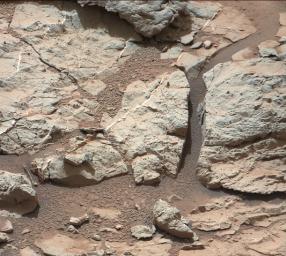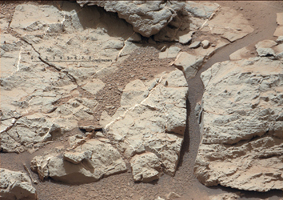
|
Veins in ‘Sheepbed’ Outcrop
- Click the image above for a larger view
- Full-Res JPEG (1344 x 1200) (456.9 kB)
- Full-Res TIFF (1344 x 1200) (4.8 MB)
Caption:

Annotated Image
Click on the image for larger version
This image of an outcrop at the "Sheepbed" locality, taken by NASA's Curiosity Mars rover with its right Mast Camera (Mastcam), shows well-defined veins filled with whitish minerals, interpreted as calcium sulfate.
These veins form when water circulates through fractures, depositing minerals along the sides of the fracture, to form a vein.These veins are Curiosity's first look at minerals that formed within water that percolated within a subsurface environment.These vein fills are characteristic of the stratigraphically lowest unit in the "Yellowknife Bay" area -- known as the Sheepbed Unit.
Mastcam obtained these images the 126th Martian day, or sol, of Curiosity's mission on Mars (Dec. 13, 2012). The view covers an area about 16 inches (40 centimeters) across.A superimposed scale bar is 8 centimeters (3.15 inch) long.
The image has been white-balanced to show what the rock would look like if it were on Earth.
Cataloging Keywords:
| Name | Value | Additional Values |
|---|---|---|
| Target | Mars | |
| System | ||
| Target Type | Planet | |
| Mission | Mars Science Laboratory (MSL) | |
| Instrument Host | Curiosity Rover | |
| Host Type | Rover | |
| Instrument | Mast Camera (MastCam) | |
| Detector | ||
| Extra Keywords | Color, Water | |
| Acquisition Date | ||
| Release Date | 2013-01-15 | |
| Date in Caption | 2012-12-13 | |
| Image Credit | NASA/JPL-Caltech/MSSS | |
| Source | photojournal.jpl.nasa.gov/catalog/PIA16705 | |
| Identifier | PIA16705 | |
